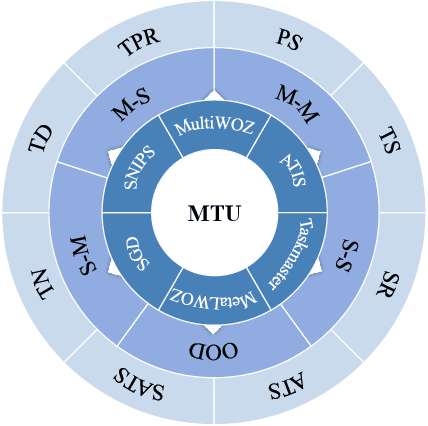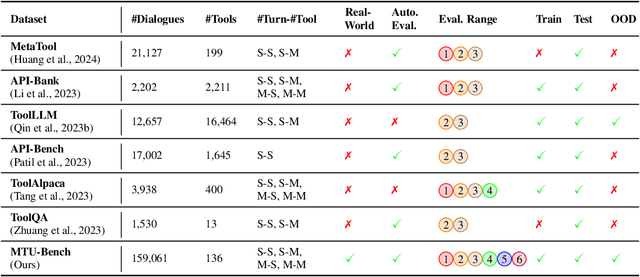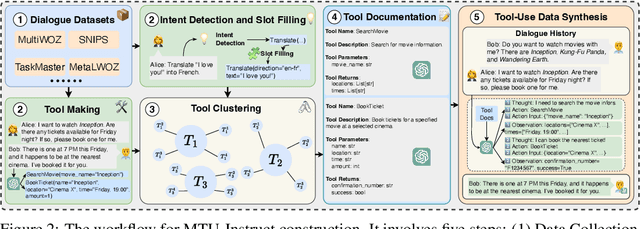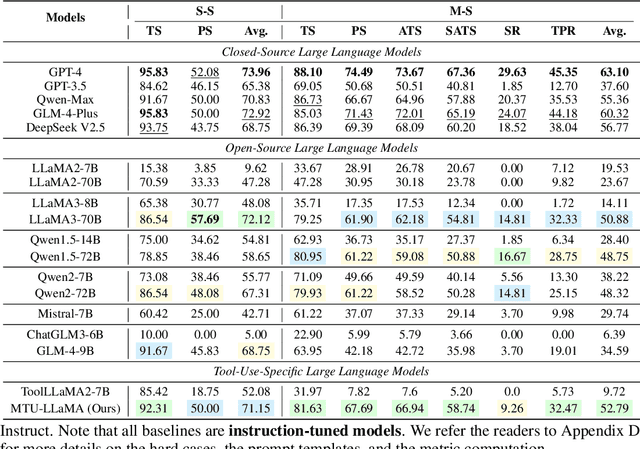Xiaoshuai Song
Face-Human-Bench: A Comprehensive Benchmark of Face and Human Understanding for Multi-modal Assistants
Jan 05, 2025



Abstract:Faces and humans are crucial elements in social interaction and are widely included in everyday photos and videos. Therefore, a deep understanding of faces and humans will enable multi-modal assistants to achieve improved response quality and broadened application scope. Currently, the multi-modal assistant community lacks a comprehensive and scientific evaluation of face and human understanding abilities. In this paper, we first propose a hierarchical ability taxonomy that includes three levels of abilities. Then, based on this taxonomy, we collect images and annotations from publicly available datasets in the face and human community and build a semi-automatic data pipeline to produce problems for the new benchmark. Finally, the obtained Face-Human-Bench comprises a development set with 900 problems and a test set with 1800 problems, supporting both English and Chinese. We conduct evaluations over 25 mainstream multi-modal large language models (MLLMs) with our Face-Human-Bench, focusing on the correlation between abilities, the impact of the relative position of targets on performance, and the impact of Chain of Thought (CoT) prompting on performance. Moreover, inspired by multi-modal agents, we also explore which abilities of MLLMs need to be supplemented by specialist models.
ProgCo: Program Helps Self-Correction of Large Language Models
Jan 02, 2025Abstract:Self-Correction aims to enable large language models (LLMs) to self-verify and self-refine their initial responses without external feedback. However, LLMs often fail to effectively self-verify and generate correct feedback, further misleading refinement and leading to the failure of self-correction, especially in complex reasoning tasks. In this paper, we propose Program-driven Self-Correction (ProgCo). First, program-driven verification (ProgVe) achieves complex verification logic and extensive validation through self-generated, self-executing verification pseudo-programs. Then, program-driven refinement (ProgRe) receives feedback from ProgVe, conducts dual reflection and refinement on both responses and verification programs to mitigate misleading of incorrect feedback in complex reasoning tasks. Experiments on three instruction-following and mathematical benchmarks indicate that ProgCo achieves effective self-correction, and can be further enhance performance when combined with real program tools.
Multi-Dimensional Insights: Benchmarking Real-World Personalization in Large Multimodal Models
Dec 17, 2024



Abstract:The rapidly developing field of large multimodal models (LMMs) has led to the emergence of diverse models with remarkable capabilities. However, existing benchmarks fail to comprehensively, objectively and accurately evaluate whether LMMs align with the diverse needs of humans in real-world scenarios. To bridge this gap, we propose the Multi-Dimensional Insights (MDI) benchmark, which includes over 500 images covering six common scenarios of human life. Notably, the MDI-Benchmark offers two significant advantages over existing evaluations: (1) Each image is accompanied by two types of questions: simple questions to assess the model's understanding of the image, and complex questions to evaluate the model's ability to analyze and reason beyond basic content. (2) Recognizing that people of different age groups have varying needs and perspectives when faced with the same scenario, our benchmark stratifies questions into three age categories: young people, middle-aged people, and older people. This design allows for a detailed assessment of LMMs' capabilities in meeting the preferences and needs of different age groups. With MDI-Benchmark, the strong model like GPT-4o achieve 79% accuracy on age-related tasks, indicating that existing LMMs still have considerable room for improvement in addressing real-world applications. Looking ahead, we anticipate that the MDI-Benchmark will open new pathways for aligning real-world personalization in LMMs. The MDI-Benchmark data and evaluation code are available at https://mdi-benchmark.github.io/
MTU-Bench: A Multi-granularity Tool-Use Benchmark for Large Language Models
Oct 15, 2024



Abstract:Large Language Models (LLMs) have displayed massive improvements in reasoning and decision-making skills and can hold natural conversations with users. Recently, many tool-use benchmark datasets have been proposed. However, existing datasets have the following limitations: (1). Insufficient evaluation scenarios (e.g., only cover limited tool-use scenes). (2). Extensive evaluation costs (e.g., GPT API costs). To address these limitations, in this work, we propose a multi-granularity tool-use benchmark for large language models called MTU-Bench. For the "multi-granularity" property, our MTU-Bench covers five tool usage scenes (i.e., single-turn and single-tool, single-turn and multiple-tool, multiple-turn and single-tool, multiple-turn and multiple-tool, and out-of-distribution tasks). Besides, all evaluation metrics of our MTU-Bench are based on the prediction results and the ground truth without using any GPT or human evaluation metrics. Moreover, our MTU-Bench is collected by transforming existing high-quality datasets to simulate real-world tool usage scenarios, and we also propose an instruction dataset called MTU-Instruct data to enhance the tool-use abilities of existing LLMs. Comprehensive experimental results demonstrate the effectiveness of our MTU-Bench. Code and data will be released at https: //github.com/MTU-Bench-Team/MTU-Bench.git.
Toward General Instruction-Following Alignment for Retrieval-Augmented Generation
Oct 12, 2024



Abstract:Following natural instructions is crucial for the effective application of Retrieval-Augmented Generation (RAG) systems. Despite recent advancements in Large Language Models (LLMs), research on assessing and improving instruction-following (IF) alignment within the RAG domain remains limited. To address this issue, we propose VIF-RAG, the first automated, scalable, and verifiable synthetic pipeline for instruction-following alignment in RAG systems. We start by manually crafting a minimal set of atomic instructions (<100) and developing combination rules to synthesize and verify complex instructions for a seed set. We then use supervised models for instruction rewriting while simultaneously generating code to automate the verification of instruction quality via a Python executor. Finally, we integrate these instructions with extensive RAG and general data samples, scaling up to a high-quality VIF-RAG-QA dataset (>100k) through automated processes. To further bridge the gap in instruction-following auto-evaluation for RAG systems, we introduce FollowRAG Benchmark, which includes approximately 3K test samples, covering 22 categories of general instruction constraints and four knowledge-intensive QA datasets. Due to its robust pipeline design, FollowRAG can seamlessly integrate with different RAG benchmarks. Using FollowRAG and eight widely-used IF and foundational abilities benchmarks for LLMs, we demonstrate that VIF-RAG markedly enhances LLM performance across a broad range of general instruction constraints while effectively leveraging its capabilities in RAG scenarios. Further analysis offers practical insights for achieving IF alignment in RAG systems. Our code and datasets are released at https://FollowRAG.github.io.
We-Math: Does Your Large Multimodal Model Achieve Human-like Mathematical Reasoning?
Jul 01, 2024



Abstract:Visual mathematical reasoning, as a fundamental visual reasoning ability, has received widespread attention from the Large Multimodal Models (LMMs) community. Existing benchmarks, such as MathVista and MathVerse, focus more on the result-oriented performance but neglect the underlying principles in knowledge acquisition and generalization. Inspired by human-like mathematical reasoning, we introduce WE-MATH, the first benchmark specifically designed to explore the problem-solving principles beyond end-to-end performance. We meticulously collect and categorize 6.5K visual math problems, spanning 67 hierarchical knowledge concepts and five layers of knowledge granularity. We decompose composite problems into sub-problems according to the required knowledge concepts and introduce a novel four-dimensional metric, namely Insufficient Knowledge (IK), Inadequate Generalization (IG), Complete Mastery (CM), and Rote Memorization (RM), to hierarchically assess inherent issues in LMMs' reasoning process. With WE-MATH, we conduct a thorough evaluation of existing LMMs in visual mathematical reasoning and reveal a negative correlation between solving steps and problem-specific performance. We confirm the IK issue of LMMs can be effectively improved via knowledge augmentation strategies. More notably, the primary challenge of GPT-4o has significantly transitioned from IK to IG, establishing it as the first LMM advancing towards the knowledge generalization stage. In contrast, other LMMs exhibit a marked inclination towards Rote Memorization - they correctly solve composite problems involving multiple knowledge concepts yet fail to answer sub-problems. We anticipate that WE-MATH will open new pathways for advancements in visual mathematical reasoning for LMMs. The WE-MATH data and evaluation code are available at https://github.com/We-Math/We-Math.
CS-Bench: A Comprehensive Benchmark for Large Language Models towards Computer Science Mastery
Jun 12, 2024



Abstract:Computer Science (CS) stands as a testament to the intricacies of human intelligence, profoundly advancing the development of artificial intelligence and modern society. However, the current community of large language models (LLMs) overly focuses on benchmarks for analyzing specific foundational skills (e.g. mathematics and code generation), neglecting an all-round evaluation of the computer science field. To bridge this gap, we introduce CS-Bench, the first bilingual (Chinese-English) benchmark dedicated to evaluating the performance of LLMs in computer science. CS-Bench comprises approximately 5K meticulously curated test samples, covering 26 subfields across 4 key areas of computer science, encompassing various task forms and divisions of knowledge and reasoning. Utilizing CS-Bench, we conduct a comprehensive evaluation of over 30 mainstream LLMs, revealing the relationship between CS performance and model scales. We also quantitatively analyze the reasons for failures in existing LLMs and highlight directions for improvements, including knowledge supplementation and CS-specific reasoning. Further cross-capability experiments show a high correlation between LLMs' capabilities in computer science and their abilities in mathematics and coding. Moreover, expert LLMs specialized in mathematics and coding also demonstrate strong performances in several CS subfields. Looking ahead, we envision CS-Bench serving as a cornerstone for LLM applications in the CS field and paving new avenues in assessing LLMs' diverse reasoning capabilities. The CS-Bench data and evaluation code are available at https://github.com/csbench/csbench.
Faceptor: A Generalist Model for Face Perception
Mar 14, 2024



Abstract:With the comprehensive research conducted on various face analysis tasks, there is a growing interest among researchers to develop a unified approach to face perception. Existing methods mainly discuss unified representation and training, which lack task extensibility and application efficiency. To tackle this issue, we focus on the unified model structure, exploring a face generalist model. As an intuitive design, Naive Faceptor enables tasks with the same output shape and granularity to share the structural design of the standardized output head, achieving improved task extensibility. Furthermore, Faceptor is proposed to adopt a well-designed single-encoder dual-decoder architecture, allowing task-specific queries to represent new-coming semantics. This design enhances the unification of model structure while improving application efficiency in terms of storage overhead. Additionally, we introduce Layer-Attention into Faceptor, enabling the model to adaptively select features from optimal layers to perform the desired tasks. Through joint training on 13 face perception datasets, Faceptor achieves exceptional performance in facial landmark localization, face parsing, age estimation, expression recognition, binary attribute classification, and face recognition, achieving or surpassing specialized methods in most tasks. Our training framework can also be applied to auxiliary supervised learning, significantly improving performance in data-sparse tasks such as age estimation and expression recognition. The code and models will be made publicly available at https://github.com/lxq1000/Faceptor.
Noise-BERT: A Unified Perturbation-Robust Framework with Noise Alignment Pre-training for Noisy Slot Filling Task
Mar 06, 2024



Abstract:In a realistic dialogue system, the input information from users is often subject to various types of input perturbations, which affects the slot-filling task. Although rule-based data augmentation methods have achieved satisfactory results, they fail to exhibit the desired generalization when faced with unknown noise disturbances. In this study, we address the challenges posed by input perturbations in slot filling by proposing Noise-BERT, a unified Perturbation-Robust Framework with Noise Alignment Pre-training. Our framework incorporates two Noise Alignment Pre-training tasks: Slot Masked Prediction and Sentence Noisiness Discrimination, aiming to guide the pre-trained language model in capturing accurate slot information and noise distribution. During fine-tuning, we employ a contrastive learning loss to enhance the semantic representation of entities and labels. Additionally, we introduce an adversarial attack training strategy to improve the model's robustness. Experimental results demonstrate the superiority of our proposed approach over state-of-the-art models, and further analysis confirms its effectiveness and generalization ability.
Beyond the Known: Investigating LLMs Performance on Out-of-Domain Intent Detection
Mar 04, 2024



Abstract:Out-of-domain (OOD) intent detection aims to examine whether the user's query falls outside the predefined domain of the system, which is crucial for the proper functioning of task-oriented dialogue (TOD) systems. Previous methods address it by fine-tuning discriminative models. Recently, some studies have been exploring the application of large language models (LLMs) represented by ChatGPT to various downstream tasks, but it is still unclear for their ability on OOD detection task.This paper conducts a comprehensive evaluation of LLMs under various experimental settings, and then outline the strengths and weaknesses of LLMs. We find that LLMs exhibit strong zero-shot and few-shot capabilities, but is still at a disadvantage compared to models fine-tuned with full resource. More deeply, through a series of additional analysis experiments, we discuss and summarize the challenges faced by LLMs and provide guidance for future work including injecting domain knowledge, strengthening knowledge transfer from IND(In-domain) to OOD, and understanding long instructions.
 Add to Chrome
Add to Chrome Add to Firefox
Add to Firefox Add to Edge
Add to Edge